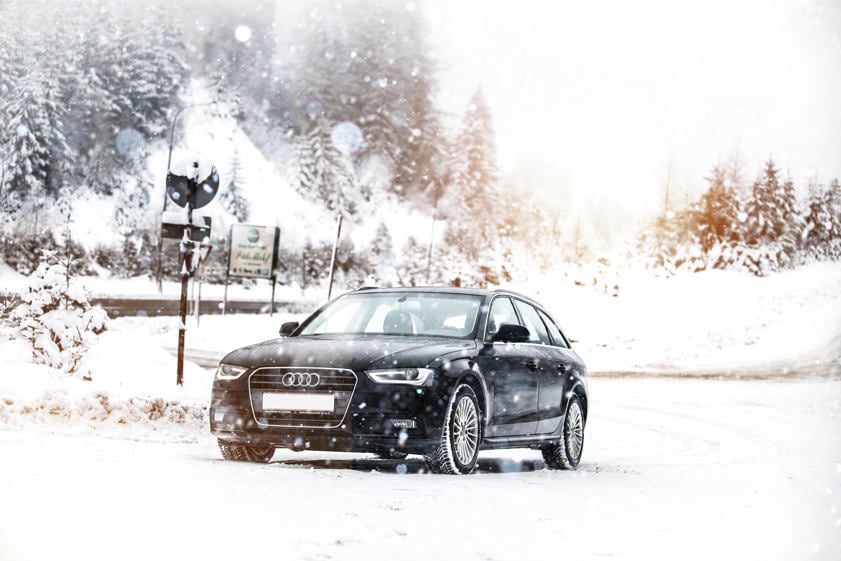
Winter driving can be challenging, but with the right preparation, you can stay safe and comfortable on the road. But what do you need for a car in winter to stay safe and avoid breakdowns? Whether you're commuting through frosty mornings or embarking on a long journey through snow-covered landscapes, ensuring your car is equipped with essential winter accessories is a must.
To make tackling the colder months easier, car leasing experts Nationwide Vehicle Contracts have compiled a list of 10 winter car essentials that every driver should have to get through to spring.
When driving in snow, what to pack for driving in snow becomes a crucial consideration. Winter tyres provide better grip and handling on icy or snowy roads. Their specialised rubber compounds remain flexible in low temperatures, allowing for improved traction, braking, and overall safety. If you live in an area prone to snow and ice, investing in winter tyres is crucial.
A de-icer spray and a sturdy ice scraper are indispensable for those frosty mornings. Quickly clearing ice from your windscreen ensures clear visibility, reducing the risk of accidents during winter.
Cold weather can be tough on car batteries. If your battery struggles or dies, jump leads can help you get back on the road quickly, especially if you can find a helping hand from a fellow driver.
A portable jump starter is a must-have for any winter driver, providing a lifeline in the event of a flat battery. This compact device can deliver a powerful jolt of electricity to jump-start your car, saving you from the hassle of roadside assistance. So, to avoid waiting for someone to help jump-start your car, a portable battery charger is a perfect solution.
Snow chains are not always needed in the UK, but they can be essential if you’re driving through heavy snow or mountainous regions. They offer increased traction on snow-covered roads, giving you more control over your vehicle.
In case of an emergency, such as getting stranded, having a warm blanket and extra clothing in your car could make a big difference. Staying warm while waiting for help is crucial to avoid hypothermia or discomfort.
A compact snow shovel can help you dig your car out of snow if you get stuck. Whether it’s clearing snow around your tyres or making a path, a shovel can save you time and effort.
Ensure your car’s windscreen remains clear by using a screenwash that works in sub-zero temperatures. Regular screenwash can freeze, but a winter-specific formula will keep your windscreen free of dirt and salt build-up.
A well-stocked emergency kit should include essentials like a first-aid kit, torch, spare batteries, non-perishable food, water, and a multi-tool. Having these items ready can be life-saving in extreme situations.
Cold temperatures can cause your tyre pressure to drop, which affects fuel efficiency and handling. Regularly checking your tyres with a gauge ensures they’re inflated to the correct levels for safer winter driving.
Beyond having the right gear, it’s important to adjust your driving habits to suit winter conditions. Here are a few basic winter driving tips to help keep you safe:
- Slow down: Ice and snow make roads slippery, so drive slower than usual.
- Increase braking distance: Leave extra space between your car and the vehicle in front of you to account for longer stopping distances.
- Use low beams in fog or snow: High beams can reflect off snow and fog, reducing visibility.
- Handle skids calmly: If you start to skid, gently steer into the skid and avoid slamming on the brakes.
It’s not just about having the right gear, regular maintenance is key to preventing problems before they arise. In winter, small issues can quickly become bigger headaches. Here’s a quick checklist of maintenance tasks you should keep on top of:
- Check your antifreeze levels to ensure your engine stays protected in freezing temperatures.
- Inspect your wiper blades, they work extra hard in winter conditions and may need to be replaced sooner than usual.
- Keep an eye on your battery’s health, batteries are more likely to fail in cold weather, so consider having it tested or replaced if it's older than three years.
Certain vehicles are better equipped to handle winter conditions, especially if you live in a region that sees more snow and ice. Here are some features to look for:
- Four-Wheel Drive (4WD) or All-Wheel Drive (AWD): These systems distribute power to all four wheels, improving traction and control on icy roads. Examples: Land Rover Defender, Subaru Outback, Audi Q5.
- Higher Ground Clearance: Cars with more ground clearance, like SUVs, can navigate deeper snow more easily. Examples: Toyota Land Cruiser, Volvo XC90, Jeep Grand Cherokee.
- Winter-Friendly Electric and Hybrid Vehicles: Many EVs and hybrids now come with winter driving modes and advanced traction systems. Examples: Tesla Model X, Ford Mustang Mach-E, Audi Q6 e-tron.
By incorporating these innovative gadgets into your winter driving arsenal, you can transform your experience from a stressful ordeal into a safe and enjoyable journey. Remember, winter driving requires extra caution and preparedness, but with the right equipment and knowledge, you can navigate the icy roads with confidence and peace of mind.
For more information, why not check out our Winter Car and Van Care guide? We also produce a range of weekly blogs on various topics, which can be found in the blog section of our website.
Nationwide Vehicle Contracts are one of the UK's leading car leasing brokers and offers a range of leasing deals to suit every need. To find out more, check out our comprehensive car leasing guides or call one of our experts on 0345 811 9595.

